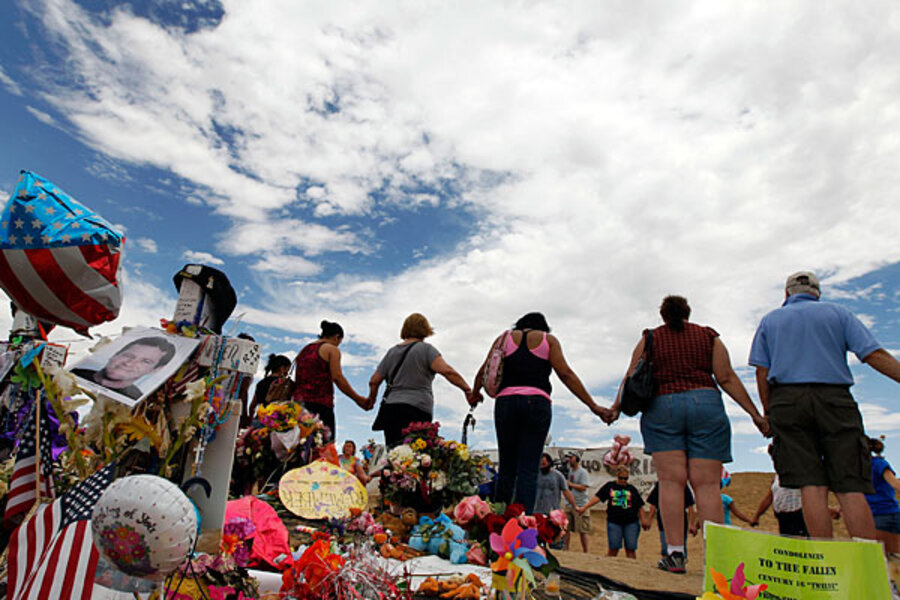Aurora shootings: What should be done with theater now?
Loading...
City officials in Aurora, Colo., are soliciting the community for feedback regarding the future of a multiplex movie theater that became the site of one of the worst mass shootings in US history.
Cinemark Holdings, Inc., a national movie chain, owns the Century Aurora 16 movie theater and will make the final decision. The theater chain contacted the city for help in hosting the survey, which is linked to from the city’s official website and Facebook page, says Kim Stuart, communications director for the city.
“The city and the theater are working together on gathering input and thoughts to provide insight and help to guide our process,” Ms. Stuart says. “The theater had wanted input, and we’re accustomed to doing that. We have a community that is really engaged, so it made sense for us to issue the survey.”
The survey tells users the city hopes “that the entire community will participate and benefit from the citywide healing process … these comments will be shared with Cinemark for consideration in their decision making process.”
Community members have until Aug. 31 to input their comments. Past that, no timeline has been established on making the final decision, Stuart says.
A gunman killed 12 people and injured 58 others on July 20 during a midnight screening of “The Dark Knight Rises.” James Holmes, the shooting suspect, is charged with 24 counts of first-degree murder and 116 counts of attempted murder. He is being held without bail while waiting trial outside Denver.
The theater has not reopened since the shooting and large fencing blocks off its parking lot. A spokesman for Cinemark did not immediately return a phone call and e-mail seeking comment.
The process in Aurora is a familiar one for communities that are forced to decide what to do with a building that becomes linked to mass violence. In an effort to move on, some choose to raze the structure and build a memorial to victims, while others decide to keep the structure and either transform it into a space that talks about violence, or return it to its former use in an effort to show that daily life should not be deterred.
In Columbine, in the Denver area, the library at the public high school where 10 students were killed in 1999 was replaced with an atrium. Similarly, the building in Ford Hood, Texas, where 13 soldiers and civilians were killed in 2009 was razed and replaced with a $16.5 million processing center for new recruits.
Likewise, the apartment building in Milwaukee where serial killer Jeffrey Dahmer murdered the majority of his 16 victims between 1982 and 1991 was demolished one year after the spree was discovered. The lot remained empty until 2011, when a building developer purchased it from the city for $500 and announced plans to divide it into private green space and a parking lot.
It is more rare when a building remains untouched following a massacre. At Virginia Tech University in Blacksburg, officials reopened the school building where a gunman killed 32 people and wounded 17 others in 2007.
The Sikh Temple in Oak Creek, Wis., reopened earlier this month after a gunman killed six people during a Sunday morning rampage one week earlier. A waist-high bullet in the door of the temple’s main prayer room was kept as a memorial to the victims.
“There’s no right or wrong way to grieve, and it’s hard to say that one idea is better than another,” says Chuck Williams, an educational psychologist and director of the Center for the Prevention of School-Aged Violence at Drexel University in Philadelphia. “What’s good is [Aurora] is asking the community. Whatever the consensus is, it’s what they should do, because it will allow the community to collectively grieve together as a unit.”
While the survey will inevitably receive opinions from outside the community, Mr. Williams says the city and theater chain should primarily heed the feedback coming from the people directly affected by the tragedy.
"Getting those stakeholders at the table and asking them what is best will help them address [the tragedy], acknowledge it, and make them able to heal and lead fully healthy and productive lives,” he says. “It turns a negative into a positive.”







